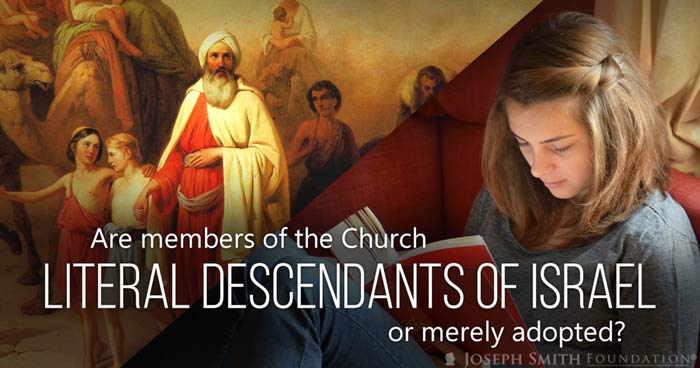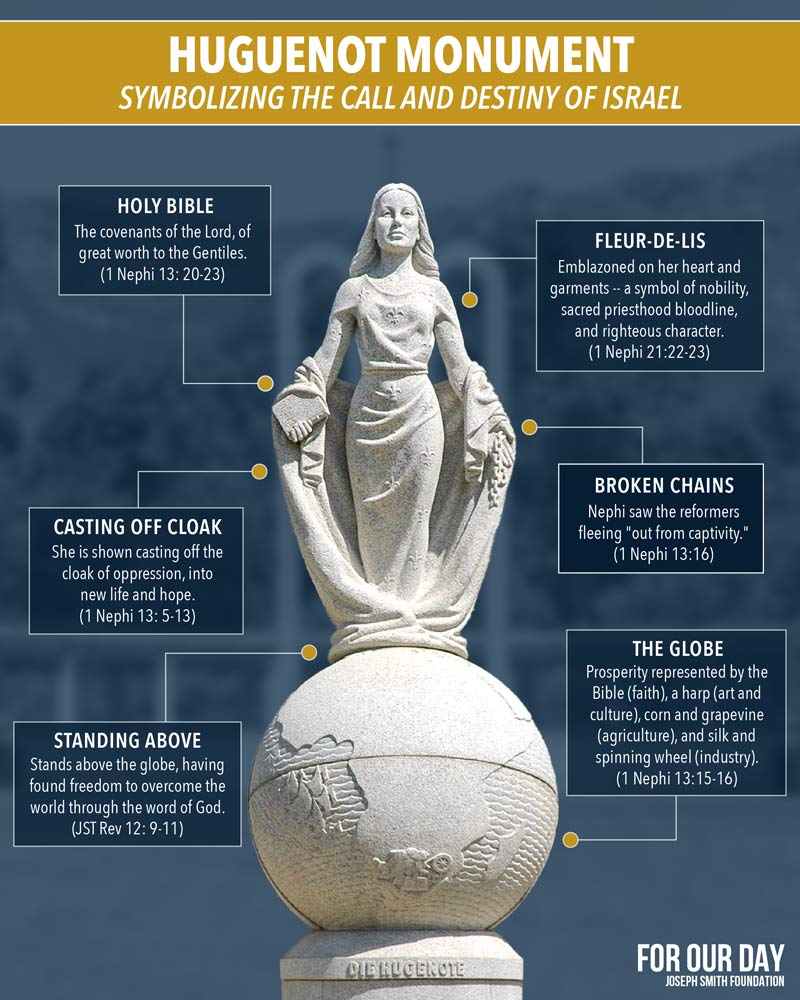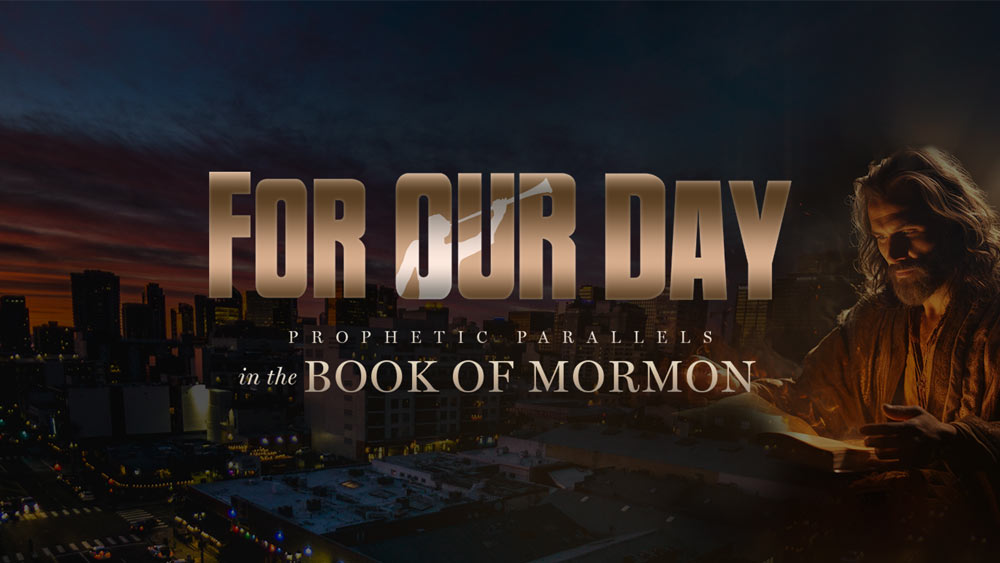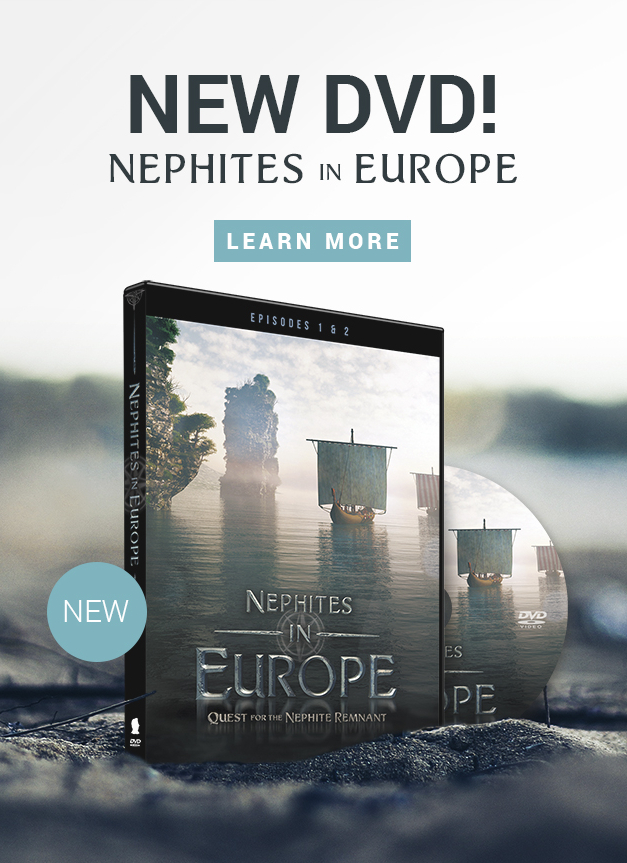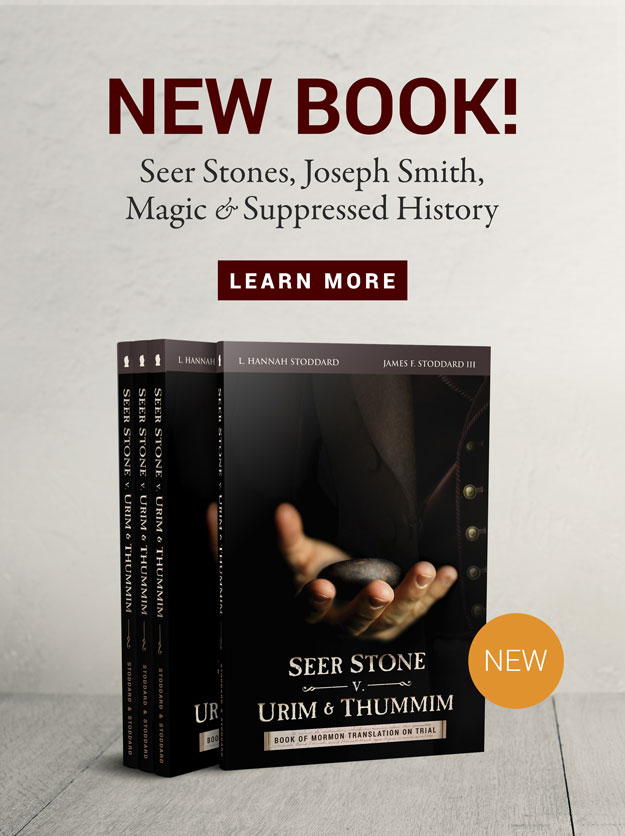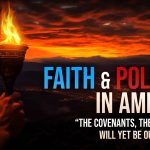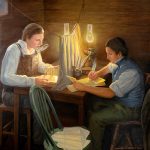Answer the Call
Lesson 4: Breaking Chains: Pilgrims, Patriots, & Power in Nephi’s Vision (Part 1)
Lesson 4: Breaking Chains: Pilgrims, Patriots, & Power in Nephi’s Vision (Part 2)
Set the Course
“It is an interesting and significant fact that in the entire Book of Mormon there are only a few latter-day individuals and groups specifically mentioned. These include Joseph Smith, who is mentioned in many passages because of his primary importance in the great latter-day work of God. Note, however, that Christopher Columbus, and those seeking religious and political freedom prior to the Revolutionary War, known as the Pilgrims, are also included in the record. Nephi records some of his vision of the Gentile nations of Northern Europe and their persecution of these faithful Pilgrim saints. He records that these Gentiles were led out of captivity by the Spirit and power of God and given an inheritance in America. The Book of Mormon proves that God intervenes in history according to the faith and righteousness of the people.
“What makes certain historical events of worth to record and remember? Is it not the eternal impact of that event on individuals? By this fundamental criterion, histories that are entirely secular are of little or no worth. The events that Nephi was shown by the Lord in vision, however, were the most significant and essential historical events of our history (1 Nephi 13). To my knowledge, there are few if any other individuals or groups that the Book of Mormon mentions in a positive light. What is the significance of these people to the gospel of Jesus Christ in this, the last Dispensation? Clearly, something essential to this work should not be overlooked. The Book of Mormon was painstakingly abridged by the prophet Mormon with a story yet to be unlocked.” (Original For Our Day book manuscript draft by James F. Stoddard III)
Quick Links to Resources Below!
Lehi & the Early Colonists of America Were Israelites
You are Israel!
The vision of the Tree of Life is a message of hope and healing for the House of Israel. When Laman and Lemuel are confused and frustrated over trying to understand their father’s experience, Nephi explains:
. . . at that day [last days] shall the remnant of our seed know that they are of the house of Israel, and that they are the covenant people of the Lord; and then shall they know and come to the knowledge of their forefathers, and also to the knowledge of the gospel of their Redeemer, which was ministered unto their fathers by him; wherefore, they shall come to the knowledge of their Redeemer and the very points of his doctrine, that they may know how to come unto him and be saved.
. . . our father hath not spoken of our seed alone, but also of all the house of Israel, pointing to the covenant which should be fulfilled in the latter days;
Are members of the Church literal descendants of Israel or merely adopted? While some believe that the majority are adopted, President Joseph Fielding Smith clearly explained that most members of the Church are literal, bloodline descendants of Abraham, Isaac, and Jacob.
The great majority of those who become members of the Church are literal descendants of Abraham through Ephraim, son of Joseph, Those who are not literal descendants of Abraham and Israel must become such, and when they are baptized and confirmed they are grafted into the tree and are entitled to all the rights and privileges as heirs.
Joseph Fielding Smith, Doctrines of Salvation, 3 vols., edited by Bruce R. McConkie [Salt Lake City: Bookcraft, 1954-1956], 3: 245. Tweet
Condescension of Jesus Christ
Nephi is taught by the Spirit that the Tree of Life symbolizes the love that the Father and His Son have for us. Our world today has many definitions of “love,” but the Book of Mormon clarifies its true definition. Nephi sees the life and labors of Jesus Christ, in addition to His crucifixion and death. We often talk about how the Son of God died for us, but how often do we talk about how He lived?
The power of Jesus Christ’s love is that He lived for years as a perfect exemplar. President Ezra Taft Benson taught a Christmas message on Jesus Christ:
. . . [H]e gave us the perfect model—himself—after which we are to pattern our lives. He said, “Greater love hath no man than this, that a man lay down his life for his friends” (John 15:13). . . . Some men are willing to die for their faith but will not fully live for it. Christ both lived and died for us. By walking in his steps and through his atonement we can gain the greatest gift of all—eternal life—which is that kind of life of the great Eternal One, our Father in heaven. Christ asked the question as to what manner of men ought we to be. He answered by saying we ought to be even as he is (see 3 Nephi 27:27). That man is greatest and most blessed and joyful whose life most closely fits the pattern of the Christ. This has nothing to do with earthly wealth, power, or prestige. The only true test of greatness, blessedness, joyfulness is how close a life can come to being like the Master, Jesus Christ. He is the right way, the full truth, and the abundant life.
Ezra Taft Benson, “Jesus Christ—Gifts and Expectations,” December 10, 1974 Devotional. Tweet
Why is Jesus Christ’s example the epitome of His love? Because without His example, we do not know the way. We do not know how to heal our marriages, overcome our depression and anxiety, defend our disappearing freedoms, reclaim our struggling teens or wayward children, or bring an end to suffering in the world. Without the life of Jesus Christ, the Atonement is useless, for we would have no standard, no model to help us see how to live with perfect joy.
Read President Benson’s full talk, “Jesus Christ: Gifts & Expectations,” for additional counsel on how to follow the example of Jesus Christ.
“Out of Captivity”
Nephi sees in vision countless centuries of history—an intense war between light and darkness to destroy the path laid out by Jesus Christ. While he witnesses millions of martyrs during the Dark Ages (see Lesson 2), he also foresees men and women breaking the chains of captivity.
A stunning portrayal of Nephi’s vision is found on the Huguenot Monument in South Africa. The term “Huguenot” was given to many of the reformers/protestants in France during the 16th century. While an estimated 2-4 million died from the wars for religious freedom during this time period, many fled the country and traveled throughout the world—carrying the blood of Israel with them.
The Huguenot Monument portrays a woman, holding the Bible in one hand and a broken chain in the other—just as Nephi saw in vision these reformers fleeing “out of captivity,” carrying the Bible with “the covenants of the Lord, which he hath made unto the house of Israel; wherefore, they are of great worth unto the Gentiles” (1 Nephi 13:16, 20-23) . Why are the covenants of Israel of “great worth” to them? Because they are Israel, and the Lord’s promises are literally being fulfilled through them.
The Huguenot woman is also shown casting off the cloak of oppression (see 1 Nephi 13:5-13). She is standing above the globe—symbolizing the freedom she has found through the word of God to overcome the world (see JST Revelation 12:9-11). Emblazoned on her heart is the fleur-de-lis, a symbol of nobility, a royal sacred bloodline, and righteous character. While she has been persecuted and driven from her home, the hope found through the word of God has enabled her to find prosperity and to forge a new world for the true King, Jesus Christ. This is represented by symbols on the globe including the Bible (faith), the harp (art and culture), the corn and grapevine (agriculture and viticulture), and the silk and spinning wheel (industry).
Also included as part of this prophetic monument is the motto of the Protestant Reformation, “lux et tenebris” meaning “light in darkness,” as well as a body of water representing peace after persecution—a new life and rebirth found through the Gospel of Jesus Christ. These Reformers laid the foundation—they were the forerunners and preparers for the Restoration of the Gospel.
Nephi also saw in vision the Prophet Joseph Smith, the coming forth of the Book of Mormon and the Restoration of the sacred covenants of Israel. In Lesson 7, we will discuss Joseph Smith’s mission to restore the covenants of Israel and how it applies to our day.
Modern Battleground
While Nephi revered the Reformers in Europe, the 17th century Puritan, Pilgrim, Covenanter, Huguenot and Quaker colonists, and the founding fathers of the United States, our textbooks and media presents an entirely contrary narrative. The faith and values of the early colonists are mocked and condemned. Watch the following clips presenting this conflict today. Where do you stand?
Were the early colonists invaders who committed atrocities?
For many years now there has been strife and debate by historians in regard to the honor of those that settled, what is now the United States, during the 14th, 15th, 16th and early 17th centuries. Some have declared that they were God fearing, faithful Christians who desired to build the Kingdom of God above all else. Others have rebutted, advancing the view that history shows seekers of gold, fish, animal skins and the god of wealth. The truth is simply that there have been both.
Recall that this is similar to the Nephite record. Not all of those aboard Nephi’s ship were coming to America to serve God with pure hearts. Certainly, Laman, Lemuel, their wives and most of their children cared little for the things of God. They traveled side by side with Nephi, Sam and their families as well as Jacob and Joseph. Certainly, this does not alter the fact that Lehi and Nephi were directed by God to come to America and that the Lord covenanted this land to them. The wicked, who came with them, were transported here to America to be a scourge to the faithful. (2 Nephi 5:25)
Were the early colonists invaders who committed atrocities?
Returning to the record of the Pilgrims, even aboard the Mayflower, there were those that ridiculed the faithful and desired the things of this world above the things of God. This was true during the entire colonization of America. Additionally, if we as stewards of this land and members of Christ’s Church are not faithful, we have been, and will be scourged by those that are wicked among us (D&C 63:31, 84:58, 124:83).
However, note the interesting fact that Nephi, while seeing the history, does not mention those that lived lives of dishonor. The wicked were not worthy to be mentioned in the record. Rather, the record speaks of those led by the Spirit of God, who were “fair and beautiful,” as were the Nephites before they fell. These faithful men and women, predominantly from Northern Europe, were those that have a history worthy of scriptural record.
Is The Scarlet Letter and The Crucible accurate history?
Note! Similar lies and false narratives have been taught concerning the Founding Fathers of America. Resources and videos presenting the true, providential history of these righteous forefathers will be included in Lesson 23.
Debunking Revisionist Attacks on Christopher Columbus
One of the men seen in vision by Nephi was Christopher Columbus.
God inspired ‘a man among the Gentiles’ (1 Nephi 13:12) who, by the Spirit of God was led to rediscover the land of America and bring this rich new land to the attention of the people in Europe. That man, of course, was Christopher Columbus, who testified that he was inspired in what he did. “Our Lord,” said Columbus, “unlocked my mind, sent me upon the sea, and gave me fire for the deed. Those who heard of my enterprise called it foolish, mocked me, and laughed. But who can doubt but that the Holy Ghost inspired me?”
Jacob Wasserman, Columbus: Don Quixote of the Seas, 19–20. The Teachings of Ezra Taft Benson (1988), 577. Tweet
Columbus’ temple work was later performed by Wilford Woodruff after he appeared with other eminent men in the St. George Temple and urged for their ordinances to be completed. (Learn more about this fascinating story here!) Christopher Columbus was also ordained a high priest at that time.
Christopher Columbus has come under heavy attack and character assassination in our day. Listen to historian David Barton as he sheds light on the true story of this eminent man.
Embark on the Journey
Monthly “I Am a Latter-day Nephite” Theme!
I will stand forth in the strength of the Lord.
Remember: While you absolutely may do every activity suggested if you would like, it is certainly not needed, nor are you limited by the ideas given here. Choose one or more that will work with your learning style, available time, or the group that you are working with. Even if you are an adult, don’t hesitate to choose an activity originally aimed at children—those can be the most fun!
Feel free to run with any other ideas that come to your mind! Allow the Lord to guide you in choosing the best activities for you. The ultimate goal is to engage with the material and become a “doer of the word.”
- If this is your first week here, welcome! Please review our Welcome & How to Join the Quest for some helpful information on how to use this resource. You may also want to check out the Embark on the Journey section of Lesson 1 for some activities that will be helpful in getting you started on this quest. In particular, you’ll want a journal, and perhaps the “I Am a Latter-day Nephite” resolution, and a fun Book of Mormon reading chart. Just start where you are in the year—don’t feel like you have to backtrack and do every lesson, but grab these helpful tools and you’ll be good to go from here!
- The oak tree and acorns are a symbol of the House of Israel. Find acorns or draw pictures of acorns. Create your own acorn pendant, wristband, medallion, or necklace symbolizing your heritage. Some may even like to weave or braid their own necklace from thin ribbon or embroidery thread, or create a small oak leaf from clay and spray paint it with gold paint. You can use materials like leather and thin chains, or buy creative materials online. Research pictures of acorns on medieval tapestries, coats of arms, or castles online, and find the significance/correlation between those emblems and where Israel was scattered. Google images of “oak leaf jewelry or ornaments” for additional ideas.
- This 1-minute video tells the story of Huguenot queen, Jeanne d’Albret for children! Watch to see how she stood up for Protestants in the Reformation.
- Study your lineage in the House of Israel as declared in your patriarchal blessing. The Guide to the Scriptures “Israel” is a great place to start. Record your thoughts and impressions in your journal.
- The attributes of Jesus Christ as exemplified during His mortal life are the key to our becoming more like Him. Read Chapter 6 of “Preach My Gospel: A Guide to Sharing the Gospel of Jesus Christ”. Which attribute do you think you do well? Which attribute have you grown the most in during your life? Which attribute is difficult for you? Make a goal with actionable steps to improve in this attribute. This could also be a great goal for your children in their Children and Youth Program booklets. Be sure to reflect on your progress as you go and record how the Spirit directs you as you seek to become more like Christ.
- Read the book Huguenot Garden by Douglas M. Jones III. There is a short (3 hours on Audible) chapter book written at an upper-elementary/middle-school reading level. It makes a wonderful family read-aloud book enjoyed by children and adults alike. You can find it on Kindle, Amazon, Audible, or ThriftBooks. Reflect on or discuss with your family the themes in this book and the character traits of the people. What can we learn about standing up for our faith in the face of persecution?
- Buy stencils of oak leaves and acorns, and create a poster of the significance of the oak tree, or a map of the world showing where Israel is symbolized by small oak leaves or acorns.
- See if you’re related to any of the early colonists on the FamilySearch Famous Relatives site. Many of them will be listed in the “Trailblazers” section. Click on your ancestors’ names to learn more about them and their stories. If you don’t have a FamilySearch account or need help navigating the website, ask your ward Temple and Family History Leader for assistance, or reach out to FamilySearch Support.
- If you choose to download or purchase a designed cardstock version of the “I’m a Latter-day Nephite” resolution, you may want to post it where you will see it every day—on the fridge or your mirror, for example. Ponder on this month’s statement “I will stand forth in the strength of the Lord.”
- Create a sculpture of the Huguenot monument out of clay, beads, paper clips, or whatever type of art form you like. Add additional features that represent Israel being gathered! Take a picture and post it on social media (Don’t forget to add #ForOurDay!).
- Persecution of God’s people continues today as Christians all over the world are persecuted and killed for their faith. Watch one or more of the videos listed below, all of which are based on true stories. Some of these may be difficult to watch – viewer discretion advised.
- Tortured for Christ (2018)
- Bible Route to North Korea
- Christian Persecution in North Korea
- Persecution and the Gospel
- Playlist by Voice of the Martyrs
- Receive your own FREE monthly magazine from Voice of the Martyrs! In each monthly issue, you will have the opportunity to 1) learn the truth about Christian persecution, 2) meet our persecuted Christian brothers and sisters, 3) be moved and encouraged by testimonies of those persecuted for their faith, and 4) learn how to pray for persecuted Christians and discover ways to help them. Join believers around the world in lifting up our persecuted Christian brothers and sisters in hostile areas and restricted nations.
- Write to Christians who are being persecuted for their faith through The Voice of the Martyr’s Prisoner Alert program. These will be translated into the appropriate language and delivered to persecuted Israel around the world!
- While we all pray that we never encounter situations like these, it is helpful to consider how we would respond if faced with persecution to this degree. Take a moment to reflect on your faith and conversion. How do you think you would respond? Could you stand strong and remain faithful? Record in your journal your thoughts and impressions.
Unless otherwise stated, reference to any products, services, hypertext link to third parties or other information by trade name, trademark, supplier or otherwise does not constitute or imply its endorsement or sponsorship by us. They are for convenience only.
All Hands on Deck
- Pray each morning this week for the Lord to give you an opportunity to share your thoughts on the Book of Mormon and/or what you’ve learned this week with someone.
- Join the For Our Day community on social media for uplifting shareable content, ideas on how to implement For Our Day in your home and classes, and to connect with others on the journey. You can find us here: Facebook, Instagram, and YouTube.
- Share a resource that impacted you from this week’s lesson with someone via text, social media, or other means. Include your thoughts and testimony.
- Pray to know how you can extend Christ’s love to someone that you know each day this week and act on it.
Footnotes
- “There are two Comforters spoken of. One is the Holy Ghost, the same as given on the day of Pentecost, and that all Saints receive after faith, repentance, and baptism. This first Comforter or Holy Ghost has no other effect than pure intelligence. It is more powerful in expanding the mind, enlightening the understanding, and storing the intellect with present knowledge, of a man who is of the literal seed of Abraham, than one that is a Gentile, though it may not have half as much visible effect upon the body; for as the Holy Ghost falls upon one of the literal seed of Abraham, it is calm and serene; and his whole soul and body are only exercised by the pure spirit of intelligence; while the effect of the Holy Ghost upon a Gentile, is to purge out the old blood, and make him actually of the seed of Abraham. That man that has none of the blood of Abraham (naturally) must have a new creation by the Holy Ghost. In such a case, there may be more of a powerful effect upon the body, and visible to the eye, than upon an Israelite, while the Israelite at first might be far before the Gentile in pure intelligence.” (Joseph Smith, Teachings of the Prophet Joseph Smith, 149-150)

